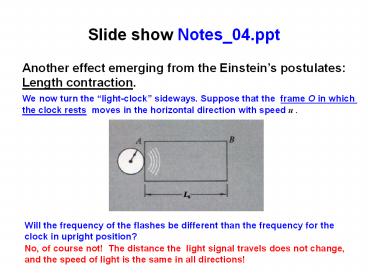Slide show Notes_04.ppt PowerPoint PPT Presentation
Title: Slide show Notes_04.ppt
1
Slide show Notes_04.ppt
Another effect emerging from the Einsteins
postulates Length contraction. We now turn the
light-clock sideways. Suppose that the frame O
in which the clock rests moves in the
horizontal direction with speed u .
Will the frequency of the flashes be different
than the frequency for the clock in upright
position?
No, of course not! The distance the light
signal travels does not change, and the speed of
light is the same in all directions!
2
Length contraction, continued
Note here the clock length is L, not
L0 because we dont know whether the observer
in O sees the same clock length.
Suppose there is another Identical clock in
frame O that moves with in the horizontal
direction with speed u relative to the
O frame. The figure shows how the observer in
the O frame sees the situation in O (a) When
the bulb is at A1 , it flashes, and the light
pulse starts traveling toward the mirror at B1
.. It reaches the mirror after time ?t1 .
However, in the period the light travels,
the entire clock shifts to the right by u?t1 .
When the signal reaches the mirror, it is
already at B2 .
3
Length contraction, continued
The same figure as in the preceding slide,
repeated
(b) The signal is now reflected and travels back
toward the bulb. but while it travels, the bulb
keeps moving. So when the signal reaches the
bulb after ?t2 , the bulb is already shifted to
the right by u?t2 from the position at which it
was at the moment of reflection. As follows from
the whole scenario depicted in the figure, on its
way toward the mirror the light signal traveled
a distance
And on the way back, a distance
Because for the observer in O the speed of light
has always a constant value of c, these distances
can also be written, respectively, as
4
Length contraction, continued
So, we get two equations which we can solve for
5
Length contraction, calculations continued
, lets stress it again, is the tick period
registered by the observer in the O system so
the clock moves relative to him/her.
We have also shown (in the preceding Notes_03.ppt
presentation) that if a time period ?t0 elapses
between two events in the O frame, than the
observer in the O frame watching the same events
registers a longer elapse of time between them,
equal to
If ?t0 is the period between the two ticks for
the observer in O, then the left-side ?t is
the same as the ?t tot we have calculated in the
preceding slide. So, we can equate the two
expressions
6
Length contraction, calculations continued (2)
We can also use the expression for ?t0 (the
tick period for the observer traveling together
with the clock) from the preceding slide show
Putting everything together
Which reduces to a compact expression
Meaning that
Objects in a frame moving relative to the one we
are in appear shorter than they really are.

